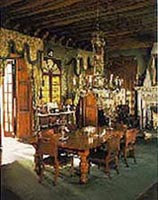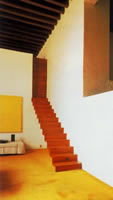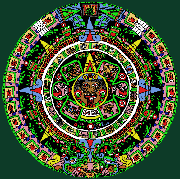|
As
you see yourself, I once saw myself; as you see me now, you will be
seen.
Mexican Proverb |

|
|
MEXICO
WORLD'S
MOST POPULOUS SPANISH COUNTRY
México
is the most populous Spanish-
speaking country in the world. According to the latest statistics, México's total population
is over 99 million. Mestizos, of Indian and Spanish blood),
make up 60%
of the population, followed by indigenous peoples
(30%), whites
(9%), and other ethnic minorities
(1%). |
|

|
|
Carnaval in Mazatlan
 Visitors
and locals scream, sing, shout and dance amid confetti and ribbons.
Bands of all kinds play the infectious rhythms of the State of Sinaloa.
And the food–oh, the food–camarones (shrimp) prepared in
every way possible, washed down with ice cold Pacifico beer, for it’s
Carnaval Time, Mazatlán’s biggest pachanga (fiesta). Visitors
and locals scream, sing, shout and dance amid confetti and ribbons.
Bands of all kinds play the infectious rhythms of the State of Sinaloa.
And the food–oh, the food–camarones (shrimp) prepared in
every way possible, washed down with ice cold Pacifico beer, for it’s
Carnaval Time, Mazatlán’s biggest pachanga (fiesta).
Read more
|
|
Updated
March
12, 2006
|
| |
MINIMALISM,
MAXIMALISM, AND MOLE
by Wendy A. Luft
 It’s
surprising to find a sumptuous mansion in the heart of a working-class
neighborhood, but during the colonial era, the Tacubaya area of Mexico
City served as a weekend getaway for wealthy families who lived in what
today is the city’s Historic Center. It’s
surprising to find a sumptuous mansion in the heart of a working-class
neighborhood, but during the colonial era, the Tacubaya area of Mexico
City served as a weekend getaway for wealthy families who lived in what
today is the city’s Historic Center.
The mansion, known as Casa de la Bola, is now a
museum that gives visitors a taste of life of the Mexican aristocracy.
The structure dates from the 1600s and over the centuries it was
inhabited by some of Mexico’s most prominent families, including an
archbishop and one of Empress Carlotta’s maids in waiting. Its most
recent occupant was don Antonio Haghenbeck y de la Lama. In 1942, this
debonair man of refined tastes, a curious combination of bon vivant and
devout Catholic, purchased the property and planted the garden with
banana and fig trees, ferns and magnolias. He covered the rooms,
including his "summer" and "winter" bedrooms, in
rich silks, filled them with inlaid furniture, Japanese urns, canopy
beds, magnificent crystal chandeliers, and ivory crucifixes, set the
dining room table with silver service plates and cut crystal, and lived
as a gentleman of the 18th century. Throughout the house,
resting on dressers and end tables, just as he left them, are Don
Antonio’s personal effects, including a collection of watches, his
reading glasses and calling cards.
At his death don Antonio left the Casa de la
Bola to the foundation that bears his name, but he made no provisions
for supporting it financially. In fact, he left the bulk of his
considerable fortune to "support Mexico’s animal life." He
inherited his love for animals – and a good deal of money, as well –
from his paternal grandfather, Doctor Carlo Haghenbeck, who founded the
Stellingen Zoo in the outskirts of Hamburg before immigrating to Mexico.
Just a few blocks away, but light years apart,
is the home, now museum, of another man of the 20th century,
Luis Barragan. Like Haghenbeck, Barragan was also debonair, a bon
vivant, and devout Catholic, and he also moved into his house in the
1940s. But there is where the similarity ends. Their two lifestyles
couldn’t have been more distinct.
The exterior of Barragan’s home is austere,
blending in with the drab surroundings of the neighborhood. But inside,
it is brilliant, exciting, and completely free of formality. The
furnishings are sparse, with warmth provided by the spatial design,
light and color, intense colors like Mexican pink, yellow, and terra
cotta. Each piece of furniture, each ornament is specific to the
particular space and reveals Barragan’s interest in popular art, seen
in the clay pitchers, blown glass, and parchment shades.
Like Casa de la Bola, Barragan’s home also
feels inhabited, and actually is. A stipend in his will allows the
couple who kept house for him until his death to live there during their
lifetime.
 Barragan
is considered one of Mexico’s foremost architects and his home one of
the most important examples of Mexican architecture. Although his degree
was in civil engineering, Barragan was a recipient of the coveted
Pritzker Architecture Prize in 1980. He had a profound influence on
younger generations of Mexican architects, including Ricardo Legorreta
who designed Mexico City’s Camino Real hotel. Barragan
is considered one of Mexico’s foremost architects and his home one of
the most important examples of Mexican architecture. Although his degree
was in civil engineering, Barragan was a recipient of the coveted
Pritzker Architecture Prize in 1980. He had a profound influence on
younger generations of Mexican architects, including Ricardo Legorreta
who designed Mexico City’s Camino Real hotel.
A treat for another of the senses is located a
few blocks from the museums: Casa Merlos, one of the city’s best
Mexican restaurants. Charming and colorful, it is very popular among
locals, but you won’t find it listed in guidebooks. The specialty is
the cuisine brought here by the proprietor, Lucila Molina de Merlos,
from her home state of Puebla. Mole in a variety of colors,
including the traditional mole poblano (Puebla-style) is featured
on the menu. Lucila carefully blends 35 ingredients to make her version,
including bitter chocolate, fruits, pumpkin seeds, nuts and a variety of
chilies. A perfect balance of sweet and piquant, it is served on chicken
or enchiladas. Another of Lucila’s specialties is pollo en pipi án,
chicken cooked in a subtle blend of green pumpkin seeds, herbs, garlic
and chili. In the late summer and fall, the menu features chiles en
nogada, poblano peppers filled with a mixture of meats, nuts,
fruits, and raisins, served with a sauce made of fresh walnuts and
cream, and sprinkled with pomegranate seeds. Accompany your order with a
cold michelada – beer (your choice of brands) and lime juice
served over ice in a salt rimmed glass – and you’re in culinary
heaven.
Casa de la Bola Museum, Parque Lira 136 (corner
Observatorio), Col. Tacubaya. Tel. 5515-5582. Open Monday through
Friday, by appointment ($4 admission fee includes guided tour in
Spanish; $5 for guided tour in English). Sunday the museum is open to
the public without prior appointment. Admission fee:$2.
Casa Luis Barragan, General Francisco Ramírez
14, Col. Tacubaya (between General José Ceballos and Constituyentes).
Tel. (525) 272-4945. Open by appointment Monday to Friday 10 a.m. to 2
p.m. and 4 to 6 p.m., Saturday 10 a.m. to 1 p.m. Entrance fee: $4
includes tour in English.
Casa Merlos, Victoriano Zepeda 80, one block
off Observatorio, Col. Tacubaya. Tel. 5277-4360. |
|

